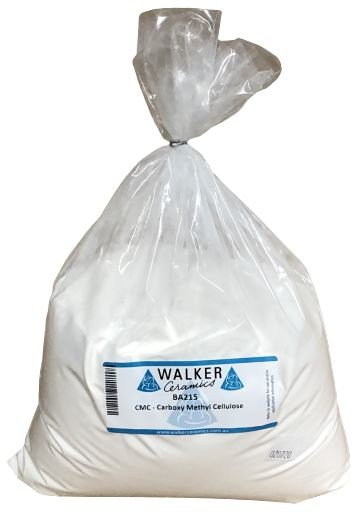- HOME
- >
- RAW MATERIALS
- >
- RAW MATERIALS
- >
- CMC - Carboxy Methyl Cellulose
CMC - Carboxy Methyl Cellulose
SKU:
A$22.00
22
66
A$22.00 - A$66.00
Unavailable
per item
The term CMC is sodium carboxymethylcellulose. Gums are used in ceramics to harden unfired ceramic glazes (cement the particles together) for safer handling of the ware. Highly fritted glazes (lacking clay content) used in factory settings benefit greatly from the addition of gum. Gum additions are often unnecessary if the glaze has natural hardening properties (i.e. from 20% or more clay). Gum is an important addition to stain mixes that are applied over-glaze by stamping or painting.
Gum can act as a suspending agent by virtue of the fact that it thickens the slurry, however the side effects may make the use other additives more attractive (i.e. an adequate amount of the right clay in the batch, Bentonite). In fact, CMC containing slurries sometimes do settle out more quickly; adding Epsom salts will help.
An important side effect of gum additions is that they cause slower drying. While this is advantageous for brushing glazes, it can make it very difficult to achieve an adequate glaze thickness and prevent drip marks. Dipping glazes work best if they are both naturally thixotropic and quick drying. Both of these properties can be detrimentally affected by gum additions.
Many people make a CMC gel by mixing 30-40 grams of powder per litre of water. This gel can then be used as part of the water amount when mixing glazes. Incorporating propylene glycol also can work well for making paintable stain mixes (i.e. 1 part thin gel with 1 part glycol).
Gum can act as a suspending agent by virtue of the fact that it thickens the slurry, however the side effects may make the use other additives more attractive (i.e. an adequate amount of the right clay in the batch, Bentonite). In fact, CMC containing slurries sometimes do settle out more quickly; adding Epsom salts will help.
An important side effect of gum additions is that they cause slower drying. While this is advantageous for brushing glazes, it can make it very difficult to achieve an adequate glaze thickness and prevent drip marks. Dipping glazes work best if they are both naturally thixotropic and quick drying. Both of these properties can be detrimentally affected by gum additions.
Many people make a CMC gel by mixing 30-40 grams of powder per litre of water. This gel can then be used as part of the water amount when mixing glazes. Incorporating propylene glycol also can work well for making paintable stain mixes (i.e. 1 part thin gel with 1 part glycol).
